Global new energy auto market in March: Italian sales increased by four digits.
In March this year, some people in the global new energy auto market were happy and some people were worried. China, Britain and France saw triple-digit growth, and Italian electric vehicle sales even increased 10 times year-on-year. However, countries striving for environmental protection, such as the Netherlands and Sweden, showed a downward trend. In terms of market share of electric vehicles, Norway is at the forefront of electrification, followed by Sweden, Germany and the Netherlands. In the first quarter of 2021, the sales of electric vehicles in China and Germany increased by three digits, and the market share is expected to expand rapidly.
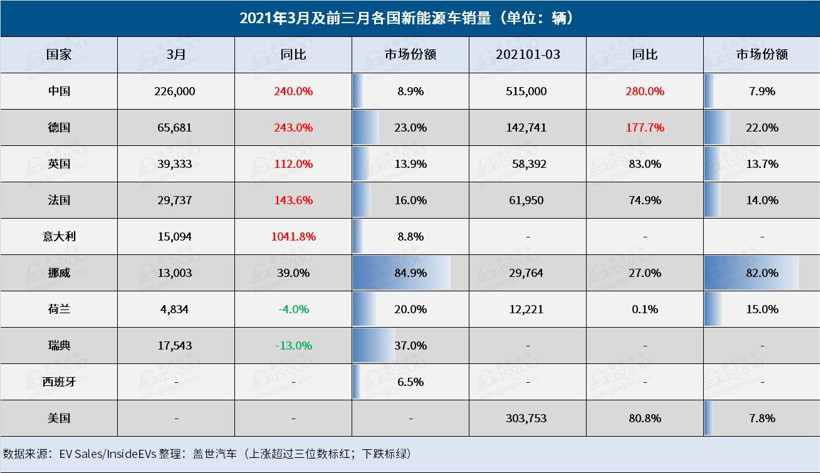
China: New energy vehicles increased by 2.4 times year-on-year. Pure electricity and plug-in continued to set a new record.
According to the production and sales data released by China Automobile Industry Association (hereinafter referred to as "China Automobile Association"), in March 2021, the production and sales of new energy vehicles in China showed a high-speed growth momentum, reaching 216,000 vehicles and 226,000 vehicles respectively, up by 74.9% and 1.1 times, up by 2.5 times and 2.4 times. In all segments of new energy vehicles, the production and sales were 182,000 and 190,000 respectively, up 2.6 times and 2.5 times year-on-year; The production and sales of plug-in hybrid electric vehicles were 34,000 and 36,000, respectively, up 2 times and 1.9 times year-on-year; fuel battery
From January to March, the production and sales of new energy vehicles both exceeded 500,000, reaching 533,000 and 515,000 respectively, up 3.2 times and 2.8 times year-on-year. Compared with January and February, the growth rate slowed down. Among the main varieties of new energy vehicles, the production and sales of pure electric vehicles were 455,000 and 433,000 respectively, up 3.6 times and 3.1 times respectively. The production and sales of plug-in hybrid electric vehicles were 78,000 and 82,000 respectively, both increasing by 1.8 times year-on-year; The production and sales of fuel cell vehicles were 104 and 150 respectively, down by 43.2% and 27.5% respectively.
Xu Haidong, deputy chief engineer of China Automobile Association, pointed out that the good performance of production and sales of new energy vehicles in the first quarter of this year is inseparable from two key factors. First, with the joint efforts of domestic and foreign car companies, new energy vehicle products can increasingly meet the needs of consumers, and the other is that the acceptance of new energy vehicle products by private consumers is gradually increasing. Based on this, the association is still optimistic about the annual sales performance of new energy vehicles.
Germany: the market share of electric vehicles reached 23%, and sales in the first quarter rose by 177%.

(Source: Tesla)
In March, Germany sold more than 65,000 electric vehicles, with a market share of 23%. Both electric vehicles and plug-in hybrid vehicles performed well. Sales of pure electric vehicles increased by 191% year-on-year to 30,101 vehicles, with a market share of 10.3%; Sales of plug-in hybrid vehicles increased by 278% year-on-year to 35,580 vehicles, with a market share of 12.2%. In the case that the overall automobile market rebounded by 36% year-on-year, the sales volume of gasoline vehicles only increased by 7% to 115,174 vehicles, with a market share of 39.4%; The sales volume of diesel vehicles decreased by 5% to 64,518 vehicles, with a market share of 22.1%.
As far as models are concerned, Tesla Model 3 won the sales crown of electric vehicles in that month and sold 3,699 vehicles. The runner-up is e-Up! EV, sold 3,599 vehicles (e-Up! It has been on the market for ten years, and the electric version was launched in 2013), and there is only a gap of 100 vehicles from the champion; Ranked third with competitive cost performance, with 3,237 registered vehicles.
In the first quarter, the sales volume of electric vehicles in Germany was 142,741, up 177.7% from 51,409 in the same period last year, with a market share of 22% (9.9% for pure electric vehicles). As far as the model is concerned, Volkswagen e-Up! EV won the first quarter electric vehicle sales crown in Germany, surpassing the second Tesla Model 3 with a gap of 1,229 vehicles, and pushed the champion .3 in December last year to the third place.
UK: Sales of electric vehicles doubled to a new high, with a market share of nearly 14%.
According to the data of the British Automobile Manufacturers and Dealers Association (SMMT), following the decline in sales in February, the number of new car registrations in the UK rebounded by 11.5% year-on-year to 283,964 in March. Considering that the exhibition hall was closed that month and the sales volume was poor in the same period last year, this is already a good result.
It is worth noting that Britain is continuing to transform into new technologies, and the number of electric vehicle registrations has increased by 112% year-on-year to 39,333, a record high. In that month, the market share of electric vehicles reached 13.9%, up from 7.3% in the same period last year. Specifically, the sales of pure electric vehicles increased by 88% year-on-year to 22,003 vehicles, with a market share of 7.7%; The sales volume of plug-in hybrid vehicles rose by 152% year-on-year to 17,330 vehicles, with a market share of 6.1%.
In the first three months, 58,392 electric vehicles were registered in the UK, up 83% year-on-year, with a market share of 13.7%. 31,779 pure electric vehicles were registered, up 74% year-on-year, with a market share of 7.5%; Plug-in hybrid vehicles registered 26,613 vehicles, up 94% year-on-year, with a market share of 6.3%.
Mike Hawes, CEO of SMMT, said: "I am optimistic that consumer confidence and the market will recover." British showrooms and other non-essential retail businesses reopened on April 12th.
France: sales of electric vehicles have tripled. Model 3 defeated Peugeot e-208 and
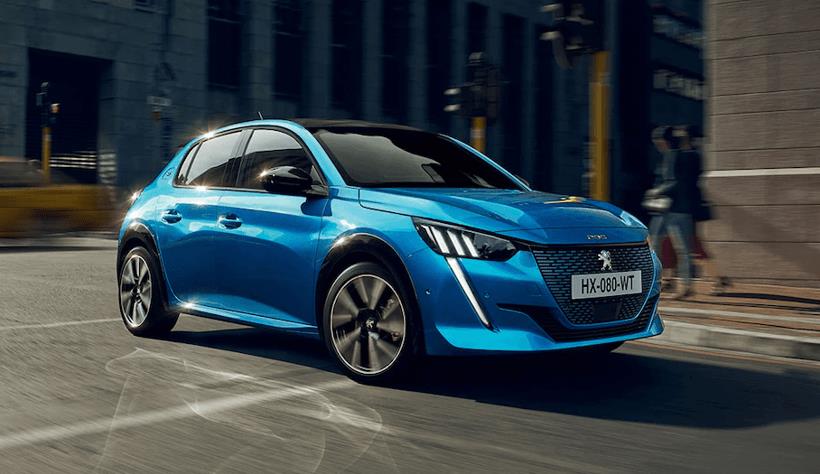
Peugeot e-208 (Source:)
In March this year, the number of car registrations in France increased by 192% year-on-year to 182,774. The electric vehicle market is even more popular, with the number of registered vehicles soaring by 306% year-on-year to 29,737 (the sales volume was low due to the epidemic blockade in the same period last year), with a market share of 16%. Specifically, the number of registered pure electric passenger cars increased by 183% year-on-year to 15,592, with a market share of 8.5%; The registered number of plug-in hybrid passenger cars soared by 682% year-on-year to 14,145, with a market share of 7.7%. In that month, the sales share of diesel vehicles dropped to 23%, the lowest level since the mid-1990s.
In March, the most shocking thing was that Tesla Model 3 registered 4,524 vehicles in France, which not only beat other electric vehicles, but also won the first quarter electric vehicle sales crown, which was a huge victory for Tesla; The runner-up of electric vehicle sales in that month was Peugeot e-208, with only 1,667 registered vehicles; The third place was the former overlord of the list, with 1,519 registered vehicles.
In the first three months of this year, the French electric vehicle market rose by 74.9% year-on-year to 61,950 vehicles, with a market share of 14%, up by 3 percentage points over the same period last year. Among them, the number of registered pure electric passenger cars increased by 18% year-on-year to 30,489, with a market share of 6.9%; Plug-in hybrid passenger cars surged 231% year-on-year to 31,461 vehicles, with a market share of 7.1%.
Italy: The electric vehicle market became a dark horse, with a year-on-year increase of 1041.8%.
In March, Italy achieved a strong recovery, with more than 171,000 vehicles registered, which was the best result since June 2019, far exceeding the less than 29,000 vehicles in March 2020. In March, Italy registered 15,094 electric vehicles, up 1041.8% from 1,322 vehicles in the same period last year, accounting for 8.8% of the market, up from 4.6% in the same period last year.
Specifically, in March, 7,362 pure electric vehicles were registered in Italy, breaking the record of 7,225 vehicles in December last year, up 695% from the same period last year, with a market share of 4.3%; Plug-in hybrid vehicles performed better, with 7,732 registered vehicles, which also reached a record high, about 20 times that of 389 vehicles in the same period last year. In that month, the market share of plug-in hybrid vehicles was 4.5%, surpassing pure electric vehicles for the third consecutive month, which is a new trend for Italy, which is more inclined to pure electric vehicles.
As far as models are concerned, in March, Tesla Model 3 returned to the top of the electric vehicle list with a registration of 1,363; Fiat 500e also performed well, ranking second with 1,056 registered vehicles, but still giving up the pure electric vehicle sales crown that has been in succession for three months, which is about 300 vehicles away from the champion; ForTwo registered 759 vehicles, ranking third.
Norway: the market share of electric vehicles accounts for four fifths, and the demand for Model 3 is strong.
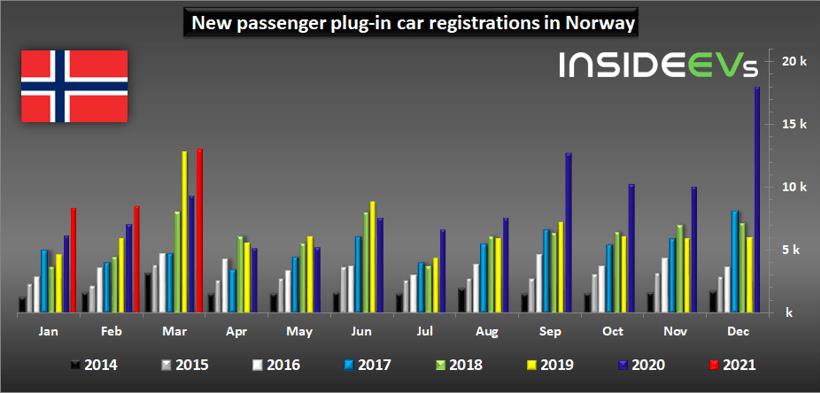
Number of registered electric passenger cars in Norway (Source: Insideevs)
In March, Norway’s electric vehicle market continued to expand, with the number of registered vehicles increasing by 39% year-on-year to 13,003, accounting for 84.9% of the total automobile market. This performance is enough to beat the performance of 5,315 Model 3s when they arrived in Norway in March 2019, but it is slightly inferior to that in December 2020.
It is worth noting that the market for pure electric vehicles and plug-in hybrid vehicles is expanding. In the same month, the registration of pure electric vehicles in Norway increased by 23.8% year-on-year to 8,624 vehicles, with a market share of 56.3%; The registered number of plug-in hybrid vehicles rose by 83.1% year-on-year to 4,379 vehicles, with a market share of 28.6%.
In the first quarter of this year, Norway registered 29,764 electric passenger cars, up 27% from the same period last year, with a market share of about 82%. Among them, there were 19,159 pure electric vehicles, up 17% year-on-year, with a market share of 52.8%; There are 10,605 plug-in hybrid vehicles, up 70% year-on-year, with a market share of 29.2%.
In March this year, the biggest star in the Norwegian electric vehicle market was Tesla Model 3, with 2,169 vehicles registered, and 2,566 vehicles registered in the first three months, which was enough to win the first quarter electric vehicle sales crown. These data are enough to alleviate the speculation of insufficient demand for Tesla, and the upcoming listing will further increase Tesla’s share. By the end of March, Tesla had sold more than 60,000 vehicles in Norway. Another strong competitor is the newly released Volkswagen ID.4, with 856 registered vehicles. This time, ID.3 is not on the Top 20 list.
Netherlands: Electric vehicle sales continued to decline, but the market share rose to 20%.

Registration of electric passenger cars in the Netherlands (Source: Insideevs)
In March, the sales of passenger cars in the Netherlands continued to decline, down 18% year-on-year, and electric vehicles were also affected. Following the 20% year-on-year decline in electric vehicle registration in February, the number of electric vehicle registrations in the Netherlands decreased by 4% year-on-year to 4,834 vehicles in March. The only positive highlight is that the market share of electric vehicles has reached 20% (9% for pure electric vehicles), an increase of 3 percentage points over the same period last year. As can be seen from the figure, the sales volume of electric vehicles at the beginning of the year is usually average (mainly due to changes in financial incentive policies), so the monthly sales volume may start to increase in the future.
As far as models are concerned, Tesla Model 3 successfully returned to the championship in the electric vehicle rankings in March, registering 341 vehicles, which is the first time that it has won the championship since September 2020. However, this is also the usual style of Tesla, and the company usually achieves high delivery in the third month of each quarter. The second place is Volvo XC40 PHEV with 257 registered vehicles; The third place is Volkswagen ID.4, with a registered volume of 247 vehicles. Interestingly, although the sales of ID.3 were hot at the end of last year, it was not on the list this time. Perhaps there are many false self-registrations that need to find buyers.
In the first quarter of this year, the number of registered electric vehicles in the Netherlands was 12,221, with a market share of 15% (5.6% for pure electric vehicles), which was 3 percentage points higher than the 12% in the same period last year. Tesla Model 3 and Volkswagen ID.4 jumped to the third and fourth place respectively in the list of best-selling electric vehicles in the Netherlands in the first three months.
Sweden: The electric vehicle market shrank by 13%, but the plug-in hybrid car rose by 212%.
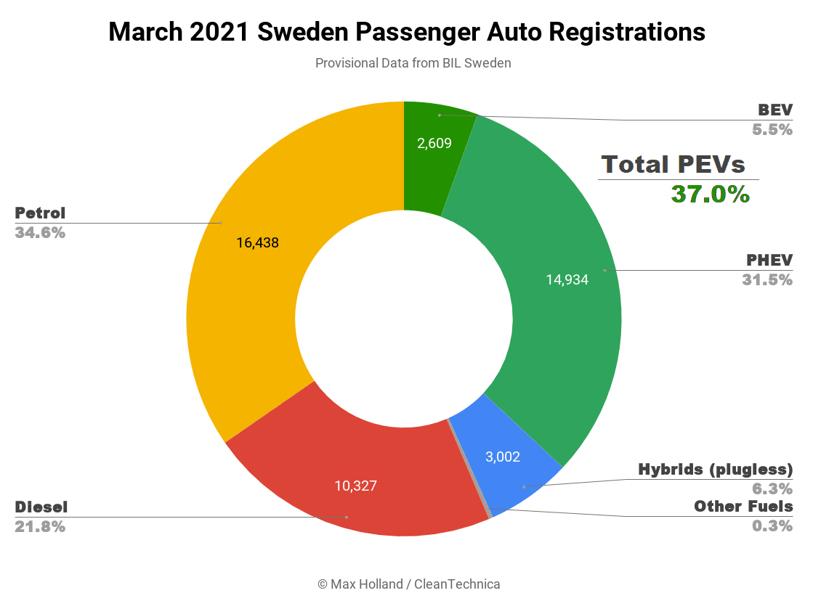
Passenger car registration in Sweden in March (Source: CleanTechnica)
In March, the Swedish electric vehicle market shrank by 13% year-on-year to 17,543 vehicles, but the market share of electric vehicles reached 37%, up from 27.2% in the same period in 2020. Unusually, the number of registered plug-in hybrid vehicles rose by 212% year-on-year, accounting for 31.5% of the market, and the share of pure electric vehicles was only 5.5%. This ratio of 6: 1 is in stark contrast to last year’s ratio of about 2.5: 1.
The reason is that since April 1st, Swedish policy has changed, and it began to be more inclined to support pure electric buses and further punish carbon emissions. Among them, pure electric vehicles increased by about 1,000 euros to 6,800 euros, which is about 25% of the price of electric vehicles; The subsidy for plug-in hybrid vehicles has been reduced from the previous 2,000 to 3,900 euros to 1,250 to 2,800 euros, with an average reduction of 1,000 euros per vehicle. Therefore, March is the "last chance" for consumers to buy plug-in hybrid cars with the best subsidies, and pure electric vehicle consumers will choose to wait until April to buy a car.
In addition, the government has also raised the annual tax on automobile carbon emissions (new cars must be paid in the first three years), making cars with carbon emissions below 90 g/km more attractive than before. In particular, vehicles with high carbon emissions, such as fuel, large and heavy internal combustion engines, will be punished, and an additional three-year tax will be paid. Non-hybrid vehicles with carbon emissions of 230 g/km, such as Volvo XC90, will have to pay about 5,000 euros.
Spain: Pure electric vehicles rose by 174%, plug-in hybrid vehicles surged by 465%
According to the data of the Spanish Automobile Manufacturers Association (ANFAC), the sales of new cars in Spain rose by 128% year-on-year to 85,819 in March. In March 2020, some dealers stopped operating in the epidemic blockade, but the sales volume in March was still far lower than that in 2019.
In that month, the electric vehicle market also performed well with a market share of 6.5%. Sales of pure electric vehicles rose by 174% year-on-year, with a market share of 2.4%, up from 2% in March last year. Plug-in hybrid vehicles surged 465% year-on-year, with a market share of 4.1%, compared with 1.7% in the same period last year. Sales of fully hybrid vehicles increased by 226% year-on-year, accounting for 22% of the market, compared with 15% in the same period last year.
The sales volume of gasoline vehicles increased by 101% year-on-year, and the market share was 48.7%, which was 6.5 percentage points lower than that in March 2020. Diesel vehicles accounted for 21.7%, down 3.1 percentage points from March 2020; LPG vehicles increased by 404%, with a market share of 1%.
On April 9, the Spanish energy department said that the government had approved a plan of 800 million euros (about 950 million US dollars). By 2023, private buyers in Spain have the right to apply for a subsidy of up to 7,000 euros per car. If the town government and enterprises buy the fleet for taxis, they will get more subsidies. Buyers of electric trucks can get subsidies as high as 9,000 euros. It is planned to take effect on April 10th.
United States: In the first quarter, the sales of pure electric vehicles nearly doubled to 100,000 hybrid vehicles.
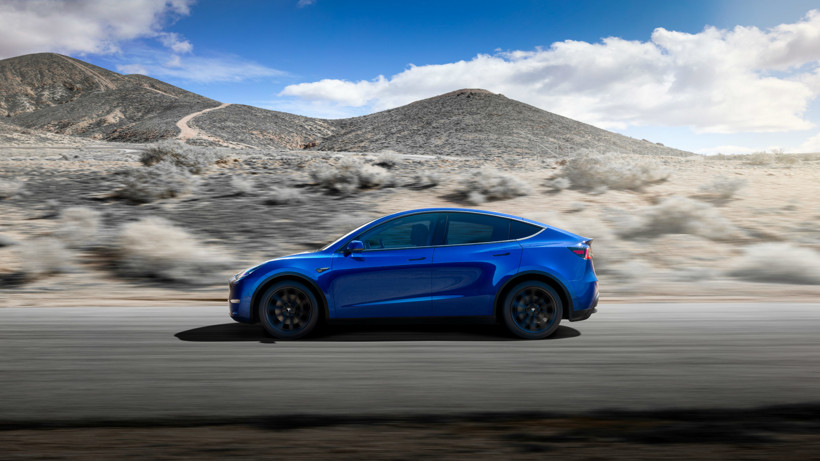
Model Y (source: Tesla)
In the first quarter of 2021, the sales of new cars in the US market increased by 11% year-on-year to 3.9 million. According to the latest report of Cox Automotive and Kelly Blue Book, the total sales volume of electric vehicles in the United States exceeded 300,000, which exceeded the overall market.
In the first quarter, the sales volume of electric vehicles in the United States was 303,753, up 80.8% from 167,966 in the same period last year, with a market share of 7.8%. Specifically, the sales volume of pure electric vehicles was 98,832, a record high, up 44.8% from 68,247 in the same period last year, with a market share of only 2.5%; The sales volume of hybrid vehicles and plug-in hybrid vehicles was 204,921, up 105.5% from 99,719 in the same period last year, with a market share of 5.2%.
In the first three months of this year, Tesla was the head player in the pure electric vehicle market in the United States, selling about 69,300 vehicles, accounting for 71% of the market, down from 83% in the same period last year. The best-selling electric vehicle in the United States is Model Y, followed by Model 3 (down 50% year-on-year), Bolt EV and Mustang Mach-E.
In the case that some brands don’t announce the sales of plug-in hybrid cars, the top three players in the hybrid/plug-in hybrid car market in the United States are: 124,449 vehicles (up 151% year-on-year), accounting for nearly 25% of Toyota’s total sales, including 32,263 Toyota Rongfang Hybrid; : More than 22,000 vehicles, accounting for 7.1% of Honda’s total sales; Ford: More than 18,000 vehicles.